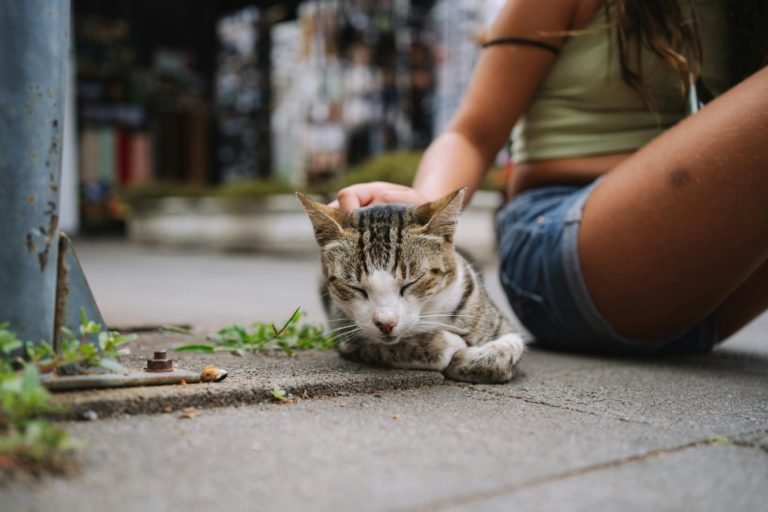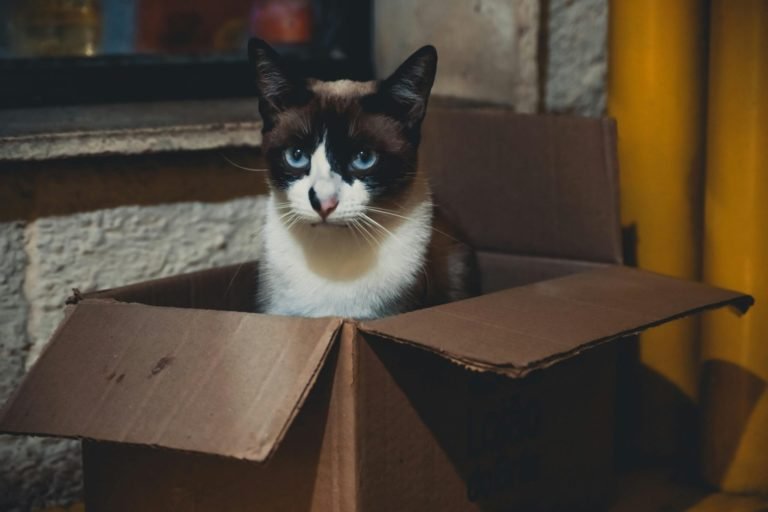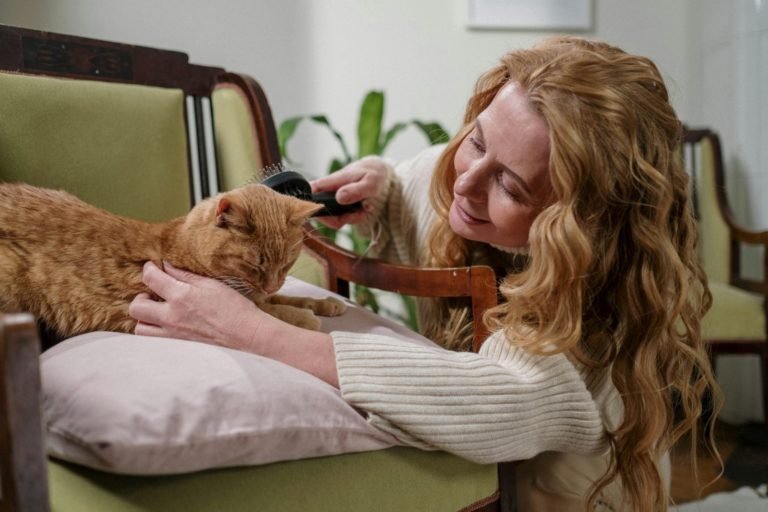
We want our cat babies to live happy, healthy and a long life. But, just like us, our cats also have to deal with health issues as they age. One such health issue is arthritis in cats.
Arthritis in cats is a degenerative joint disease. It causes significant pain and reduces the mobility of the cat. Arthritis in cats negatively affects your cat’s quality of life and comfort.
Arthritis in cats is a complex and chronic condition. It causes significant physical discomfort. It also causes emotional pain for both the cats and the cat’s parents.
The pain and discomfort of arthritis in cats often result in changes in mood and behavior. Cats often get depression as they can not move freely. This adaptation to the limitation of arthritis in cats results in frustration and stress. Watching your cat baby in pain is distressful for the pet owners. Long-term care for arthritis in cats puts emotional and financial strain on the cat owners.
But don’t let that scare you! You can still ensure a happy and comfortable life for your cat. Read on to find out how to support your arthritic cat.
Understanding Arthritis in Cats
Arthritis is a condition of inflammation of the joints. Arthritis in cats occurs when the cartilage within the cat’s joints deteriorates. This process results in changes in the bones and surrounding tissues of the joints. Arthritis can affect any joint in the cat’s body. But, it most commonly affects the joints in hips, knees, elbows, shoulders, lower back, spine, and ankles.
The most common form of arthritis in cats is osteoarthritis or the Degenerative Joint Disease (DJD). Age-related wear and tears in the cartilage are the most common cause of osteoarthritis.
Arthritis in cats could also be in the form of rheumatoid Arthritis, an autoimmune disorder. Here, the immune system of the cats attacks the joints. This type of arthritis in cats is not very common. Viral, bacterial, or fungal infections can also cause infectious arthritis in cats. Sometimes, cats develop traumatic arthritis in the joints following an injury.
Causes and Risk Factors of Arthritis in Cats

As the cats become older, arthritis in cats becomes more common. If you understand the causes and risk factors, you can detect it early. You can also take preventive measures to minimize the risk and severity of arthritis in cats. So you can ensure a good quality of life and effective pain management for your cat baby.
1. Age: The Primary Risk Factor of Arthritis in Cats
As your cats grow older, their joints naturally experience wear and tear. This damage results in a gradual breakdown of the cartilage that cushions the cat’s joints. When the cartilage degenerates, the bones of the joints begin to rub against each other. This rubbing results in pain and inflammation. Arthritis in cats also limits the cat’s mobility. If you have a cat that is over 12 years old, it is likely to have arthritis. So, regular vet checkups are crucial to catch this condition early and begin treatment.
2. Risk Factor of Obesity Leading to Arthritis in Cats
Obese cats are more at risk of arthritis in cats than the slimmer or slighter cats. When a cat is obese, the excess weight puts additional pressure on the cat’s joints. The excess weight majorly affects the joints in the hips, knees, and spine. This extra pressure speeds up the wear adn tear of the cartilage. Which leads to an earlier onset of arthritis in cats and also causes more severe symptoms. Weight management is crucial for preventing and delaying the onset of arthritis in cats.
3. Genetic Predisposition in Certain Breeds for Arthritis in Cats
Some breeds have a more genetic predisposition for arthritis in cats than others. For instance, Scottish folds are at a greater risk of early-onset arthritis. This breed might get arthritis not only in joints but also in the tail and the spine. Some breeds, like Maine Coons and Persians, are at risk of arthritis in cats due to conditions such as hip dysplasia. If you have such a breed, then regular vet checkups and monitoring become crucial.
4. Arthritis in Cats Due to Previous Injuries
Injuries like fractures and dislocations put your cat at a higher risk of developing arthritis in the injured joints. Even after complete healing of the injury, the joint will be at risk of degeneration. The pain and damage of some injuries cause changes in the cat’s gait or walking style. This change can put abnormal stress on the joints, which results in the development of arthritis in cats. Proper treatment and rehabilitation after injury are crucial for preventing arthritis in cats later in life.
5. Congenital Joint Defects: Early-Onset Arthritis in Cats
Some cats might develop congenital joint defects in the womb. The most common congenital joint defects are hip dysplasia and luxuating patella. These congenital joint defects increase your cat’s risk of developing arthritis. For example, when the kitty has hip dysplasia, its hip joint won’t fit properly into the socket. This defect leads to abnormal wear and tear of the joints and hastens the degeneration of joints. Cats with congenital defects usually show signs of arthritis very early. Early intervention can help to control the severity of arthritis in cats.
6. Infectious Arthritis in Cats
Cats get infectious arthritis from the infections and diseases that affect the joints. Your cat can get infections from a bite wound or systemic infections. Sometimes, surgical procedures can also cause infections. Bacteria, fungi, and viruses invade the joints and cause inflammation. This inflammation damages the cartilage and the surrounding tissues which leads to degeneration of joints. Symptoms of infectious arthritis in cats are swelling and pain in the affected joint. Your cat might also get a fever and become lethargic. Prompt medical care will protect your cat against permanent joint damage from infections.
7. Immune System Disorders Resulting in Autoimmune Arthritis in Cats
When a cat has an autoimmune disease, the body’s immune system will attack its own tissues and joints. If the cat has feline rheumatoid arthritis, the immune system attacks the lining of the joints. When this membrane is damaged, it results in inflammation and pain. Eventually, the cat will get joint deformities. Autoimmune arthritis requires long-term and intensive treatment to address inflammation.
8. Environmental Factors Aggravating the Symptoms of Arthritis in Cats
Environmental factors do not cause arthritis in cats directly. However, such factors can aggravate the symptoms and cause discomfort to the cat. For example, cats living in cool, dark weather experience more stiffness and pain in their joints. If the cat has to jump or climb repeatedly, it will strain the joints. This daily wear and tear can increase the risk of arthritis in cats.
Recognizing the Signs and Symptoms of Arthritis in Cats
Cats are very good at hiding their pain. If your cat has discomfort, the signs will be very subtle. So, as the cat parent, you have to become extra observant to identify early signs of arthritis in cats.
A more common sign of arthritis in cats is an unusual reduction in activity. If your cat is not jumping, climbing, or playing around as much as before, it might be a cause for concern. The cat might also feel difficulty in movement due to the stiffness of joints. This difficulty in movement results in the cat sleeping more. The cats will also lose muscle mass and gain weight due to inactivity.
As the joints become stiffer, the cats can not reach all the areas of their body. So, the cats will start to groom less. The stiff joints also make climbing in and out of the litter box harder. So, the cat will either avoid the litter box or have accidents outside the box.
Your cat will become grumpy or aggressive if you touch the painful joints. As the pain increases, the cat will begin to meow and cry. The pain also makes the cat limp or favor certain limbs to avoid pain. Some cats also have subtle swelling in the joints.
Diagnosis of Arthritis in Cats
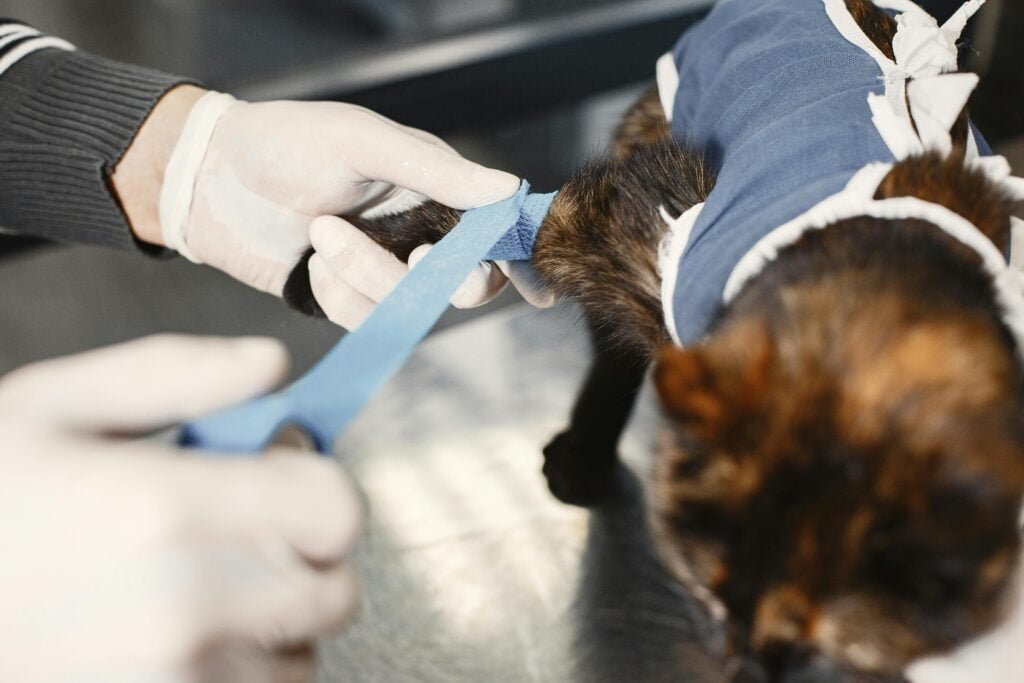
Early diagnosis helps in minimizing complications and making your cat comfortable. However, diagnosis of arthritis in cats is challenging because the onset of symptoms is usually very gradual and subtle. Cats are not very expressive about their pain. And the symptoms of arthritis in cats are very similar to some neurological conditions.
Arthritis in cats is diagnosed with a combination of physical exams, medical review, and diagnostic tests.
1. Veterinary Examination
Your veterinarian can identify symptoms of arthritis in cats with a thorough physical exam. The key areas for observation are – the cat’s gait, movements, swelling or pain in joints, muscle mass assessment, symmetry, and range of motion. The vet will also ask for medical history. Be prepared with details of – changes in behavior, previous injury, activity levels etc. A combination of physical exam and medical history helps to arrive at an accurate diagnosis.
2. Diagnostic Tests
Radiographs or X-rays help to identify bone spurs, changes in bone density, narrowing of joint space, and swelling of soft tissue. Blood tests can not identify arthritis. But, blood tests will help to rule out other conditions and lead to speedy diagnosis. Analysis of joint fluids helps to diagnose immune-related and infectious arthritis. Advanced imaging techniques like MRI provide detailed images of soft tissues and cartilage.
Treatment Options for Arthritis in cats
You have to combine various treatments for the treatment of arthritis in cats. You have to provide treatments for pain and mobility. You will also have to take measures to slow down the progression of arthritis in cats. Again, these treatments have to be tailored to the symptoms and severity of specific cats. All the treatments need the expert overview of your veterinarian and regular monitoring for adjustments.
1. Pharmacological Treatments
Non-steroidal anti-inflammatory Drugs (NSAIDs) like Meloxicam and Robenacoxib help to reduce pain and inflammation in the joints. But this option has a lot of side effects. Pain medications like ibuprofen help with short-term pain relief. There are also options for corticosteroids, adequate Injections, and Amitriptyline to help improve joint health. Nutraceuticals and Supplements like Glucosamine and CBD oil might also support joint health.
2. Physical Therapies
Physical therapies are a gentle and non-invasive way of managing arthritis in cats. Physical therapy is great for relieving pain and improving mobility. It helps to improve the overall quality of life for the cats. Acupuncture is the old Chinese therapy that uses needles to address the inflammation in joints and muscles; it can help with pain relief and mobility for your cat. Massage therapies also help to improve circulation and relieve muscle tension. Physical therapy with gentle exercises and stretches helps to improve joint flexibility.
3. Environmental Modifications
Arthritis in cats impacts your pet’s mobility. If you adapt the house to ease their movements, it will help with arthritis pain management in cats. Soft and warm bedding provides a cushioning effect to relieve the pressure on joints. Low-sided litter box minimizes the movement of legs; it helps the cat to access the litter box without any issue. Non-slip mats also help with balance and keep your cat safe. Elevated feeding stations for food and water will ease the pressure on the shoulder and neck.
Long-Term Management and Home Care for Arthritis in Cats
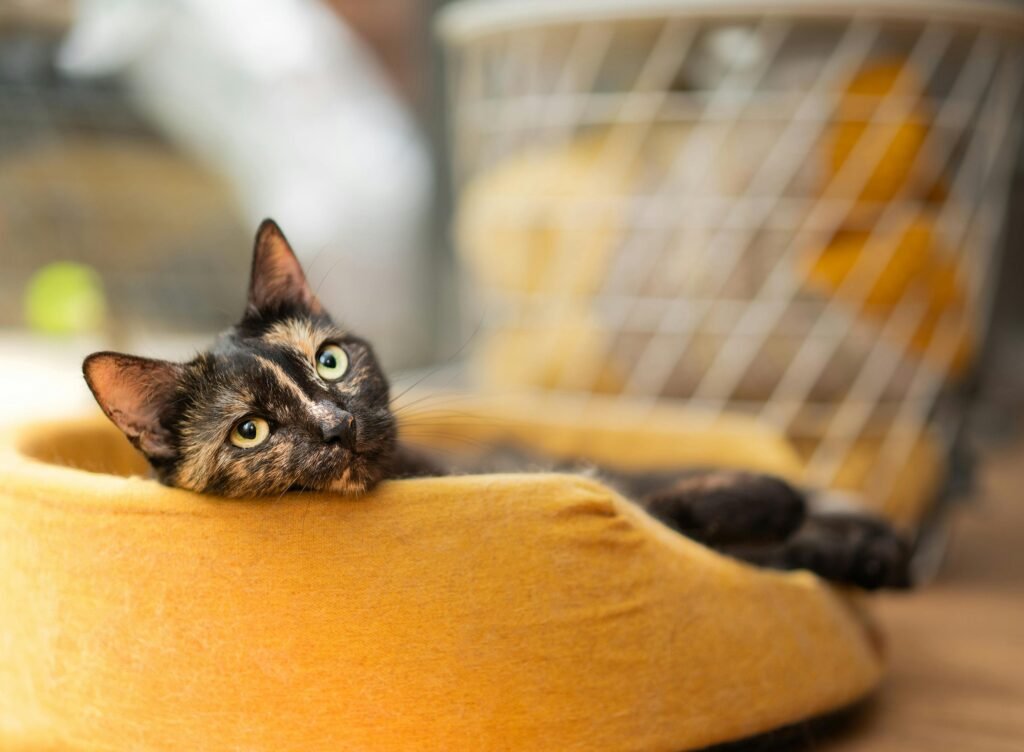
Managing arthritis in cats is a long-term commitment for the pet parents. The focus of the treatment is on pain relief, slowing the progression of arthritis, and maintaining the cat’s quality of life.
Environmental adaptations such as soft bedding, low litter boxes, accessible perches and feeding stations will make your cat’s life easier. Using rugs and nonslip mats also supports the cat if arthritis causes balance issues. Your cat will also need your help with grooming the hard-to reach areas.
You should encourage gentle play sessions. Care should be taken to not put more strain on the paining joints. Physical activity and exercise should be done in short stretches and low-intensity sessions.
If your cat can tolerate water, swimming is an excellent exercise option. Regular physical therapy will also help with improving the range of motion in the joints. You can also use gentle massages at home for pain relief. Heat therapy with a warm compress and cold packs can help to relieve sore joints.
A balanced diet is crucial for not just overall wellbeing, but also for weight management. A healthy weight will help to reduce the strain on the joints of the cat. The food should be easy to eat and swallow to make it easier for the cat.
It would help if you kept a regular log to track your cat’s symptoms and treatments. Regular vet appointments help you catch and address the issues early. Having a routine and spending quality time will comfort the cats with arthritis. You can offer treats and praise to encourage your cat to go through treatments.
How to Prevent Arthritis in Cats
In most of the cases, arthritis can not be prevented. But, cat parents can take some steps to slow down the degeneration of the joints. These measures will also help to delay the onset of arthritis and its severity in the future.
If you maintain a healthy weight, it will prevent excess stress on the joints. Regular exercise will help to protect the flexibility of joints and the strength of muscles. It would help if you also created a joint-friendly environment that eases the stress on your cat’s joints.
A high-quality diet will also be crucial for preventing inflammation and prevent obesity. Joint supplements also help to promote joint health. Regular veterinary checkups will help you identify arthritis in cats early and address the joint issues promptly.
Conclusion
Arthritis in cats is a chronic condition. So, the management strategy has to evolve as the condition evolves over the years. You should reassess your cat’s diet, medication, and environment from time to time. Depending on the change in situation, you should make the adaptations. You should also be open to trying alternative therapies and new treatments as your vet recommends them.
Remember that every cat is unique. Focus on finding a treatment plan that meets the specific needs of your cat. And when you see how comfortable your cat baby is, all your efforts will feel justified.


